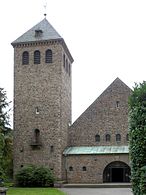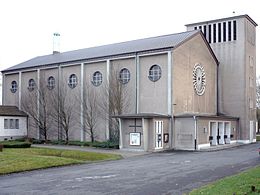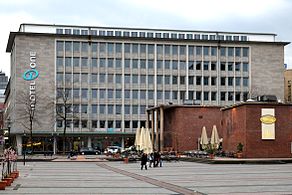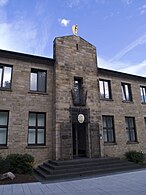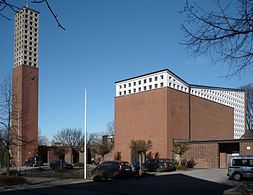Emil Jung
Johannes Emil Friedrich Jung (born January 26, 1882 in Essen ; † November 30, 1964 ) was a German architect who was responsible for formative buildings in his hometown of Essen.
Life
Born as the son of an innkeeper, he graduated from high school there in 1902 after attending the Burggymnasium in Essen . He then studied architecture at the Technical University (Berlin-) Charlottenburg , in Munich and in Stuttgart . A traineeship followed his studies, and after passing the 2nd state examination , he was appointed government master builder ( assessor in the public building administration). This was followed by trips that took him to Italy , France and the Netherlands .
In March 1913, Jung became a technical employee at the city expansion office in Essen. This was followed by his participation in the First World War as an observation officer in the airship force . Emil Jung was awarded the Iron Cross 1st and 2nd class as well as the papal New Year's Eve .
After the end of the war he began a career of more than forty years as a freelance architect in Essen.
He was buried in the Catholic cemetery at St. Markus in Essen- Bredeney .
architecture
style
Emil Jung represented a "semi-modern conception of architecture". His buildings are an example of the “architectural-historical position between tradition and modernity”. Jung's buildings with their "quarry stone facades (...) in form and materiality show clear regional references". Jung's last buildings also demonstrate a “sweeping lightness and elegance in lines and details”.
buildings
The Erzhof as today's administration of the Ruhrbahn in Rüttenscheid was built in 1922 according to plans by Emil Jung as an administration building for trade and industry, as the Dr.-Paul-Meyer-Haus for the Berlin company Dr. Paul Meyer AG, special factory for electrical switchgear, measuring devices, apparatus and meters built.
In 1933 Jung built the Holy Spirit Church from the former Blass & Son oil factory located on the Oelberg in Katernberg, which was consecrated to the holy martyrs Amantius and Innocentia . The building, which has since been closed after being damaged in the war, was rebuilt in 1957 by Gottfried Böhm with a tent-like roof structure.
The hospital on Lazarettstrasse in Essen's Westviertel was built in 1937 according to Emil Jung's designs and is the forerunner of today's Alfried Krupp Hospital in Rüttenscheid . The corners of the building are rounded. The head building is lavishly clad and the portal is decorated with sandstone reliefs. A relief shows the three Krupp rings combined with the Aesculapian staff .
In 1937, Emil Jung created the St. Joseph Church in the district of Kettwig in front of the bridge with echoes of a medieval fortified church . Elements such as the quarry stone facade, compact proportions and small arched windows characterize the Christian sacred building, which ties in with the regional building tradition.
The St. Stephanus Church, built in 1953 and profaned in 2008 , is of monument quality. The entrance area originally had columns. The facade of the round church is adorned with a large rose window reminiscent of medieval cathedrals . The church tower stands, like a campanile , away from the church and is connected to the rotunda with a portico . It is scheduled to be demolished in early 2018. The previous building from 1930, which was destroyed in the war, was also based on his design.
The three-aisled church of St. Gertrud , which was destroyed in the Second World War and was built between 1872 and 1877 according to a design by August Rincklake in the northern city center , was rebuilt by Emil Jung in major changes by 1955. Jung also had the St. Dionysius Church from the 1860s in Borbeck , which was also destroyed during the war, rebuilt in 1951 in a modified manner. It has been a listed building since 1987 . In 1952, when the Church of St. Peter in the north quarter , which had been closed since 2008, was decisively involved in the repair of the building after war damage.
The Heroldhaus from 1955, which was listed in 2010 as a listed building, has extensive cladding made of natural stone slabs. The parapets are made of this material, as are the closed sides of the outer walls. In 2012, the former insurance building was redesigned in accordance with a listed building and reopened as a hotel.
The last church building by Emil Jungs, St. Ignatius in the southern quarter from 1960, was the church of the former Jesuit monastery, whose order left the city of Essen in 2012 after around 400 years. The free-standing tower was put down in November 2013 because it was dilapidated and the church rooms for parts of the parish of St. Gertrud were renovated.
Jung's other buildings are the Maria im Maien chapel in Kettwig-Pierburg from 1932, the church of St. Winfried in Kray from 1954 , which was closed in spring 2016, and the bishop's house from 1955 to 1956.
Among other things, Jung was involved in the expansion of the BMV school in Holsterhausen . After the Second World War he spent a long time rebuilding the Essen minster .
- Buildings by Emil Jung (selection)
Maria im Maien Chapel, Kettwig- Pierburg (1932)
St. Stephanus, Holsterhausen (1953; laid down in 2018)
St. Winfried, Kray (1954; resigned in 2016)
Heroldhaus, Essen city center (1955)
St. Gertrud , rebuilt changed by Jung (1955)
Bishop's House, on Burgplatz (1956)
St. Ignatius , Südviertel (1960; tower laid down in 2013)
literature
- Robert Volz: Reich manual of the German society . The handbook of personalities in words and pictures. Volume 1: A-K. Deutscher Wirtschaftsverlag, Berlin 1930, DNB 453960286 , p. 857.
- Holger Krüssmann: Architecture in Essen 1900–1960 . Ed .: Berger Bergmann, Peter Brdenk. Klartext-Verlag, Essen 2012, ISBN 978-3-8375-0246-6 .
- Erwin Dickhoff: Essen heads . Ed .: City of Essen, Historical Association for the City and Abbey of Essen. Klartext, Essen 2015, ISBN 978-3-8375-1231-1 , p. 176 .
Web links
Individual evidence
- ↑ a b Monument Protection - Description Heroldhaus ; Retrieved January 5, 2017
- ↑ Krüssmann, p. 158, No. 101 (Heroldhaus; architect: Emil Jung; built in 1955; location: center, Kennedyplatz 3).
- ↑ a b Krüssmann, p. 199 [biography]
- ↑ Excerpt from the list of monuments of the city of Essen, Erzhof ; Retrieved January 5, 2017
- ↑ Krüssmann, p. 161, No. 104 (Heilig Geist Kirche; Architects: Emil Jung, 1933 / Gottfried Böhm, 1957; Location: Katernberg, Meybuschhof 13).
- ↑ First Church of the Holy Spirit, image on st-jupp.de ; accessed on May 18, 2016
- ↑ First Church of the Holy Spirit (interior), image on st-jupp.de ; accessed on May 18, 2016
- ↑ First Holy Spirit Church, history on st-jupp.de ; Retrieved May 19, 2016
- ↑ Krüssmann, p. 138, No. 81 (Hospital Lazarettstrasse; architect: Emil Jung; built in 1937; location: center, Lazarettstrasse 7).
- ↑ Krüssmann, p. 139, no. 82 (St. Josef in front of the bridge; architect: Emil Jung; location: Kettwig, Heiligenhauser Straße 2).
- ↑ Krüssmann, p. 144, No. 88 (St. Stephanus; architect: Emil Jung; built in 1953; location: Holsterhausen, An St. Stephanus 2).
- ↑ DerWesten.de of March 10, 2016: St. Stephen's Church is to be demolished, accessed on May 19, 2016
- ^ Heinz Dohmen, Eckhard Sons: Churches, chapels, synagogues in Essen. Nobel, Essen 1998, ISBN 3-922785-52-2 , p. 83.
- ↑ Excerpt from the list of monuments of the city of Essen, St. Dionysius ; Retrieved January 5, 2017
- ↑ Excerpt from the list of monuments of the city of Essen, Heroldhaus ; Retrieved January 5, 2017
- ↑ Krüssmann, p. 158, No. 101 (Heroldhaus; architect: Emil Jung; built in 1955; location: center, Kennedyplatz 3).
- ↑ Krüssmann, p. 177, No. 120 (St. Ignatius; architect: Emil Jung; year of construction 1960; location: Südviertel, An St. Ignatius 10).
- ↑ Derwesten.de of November 20, 2013: Church tower of St. Ignatius in Essen-Holsterhausen is demolished ; Retrieved May 19, 2016
- ^ Historical Association for the City and Monastery of Essen, Monument Path, Burgplatz ; Retrieved May 19, 2016
| personal data | |
|---|---|
| SURNAME | Young, Emil |
| ALTERNATIVE NAMES | Jung, Johannes Emil Friedrich (full name) |
| BRIEF DESCRIPTION | German architect |
| DATE OF BIRTH | January 26, 1882 |
| PLACE OF BIRTH | eat |
| DATE OF DEATH | November 30, 1964 |
| Place of death | eat |


